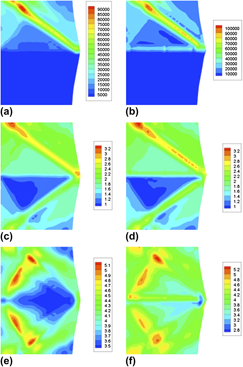Crossref Citations
This article has been cited by the following publications. This list is generated based on data provided by
Crossref.
Chakrabarty, Shanta
Mishra, Sushil K.
and
Pant, Prita
2014.
Crystallographic orientation and boundary effects on misorientation development in austenitic stainless steel.
Materials Science and Engineering: A,
Vol. 617,
Issue. ,
p.
228.
Smith, Laura
and
Farkas, Diana
2014.
Non-planar grain boundary structures in fcc metals and their role in nano-scale deformation mechanisms.
Philosophical Magazine,
Vol. 94,
Issue. 2,
p.
152.
Bayerschen, E.
McBride, A. T.
Reddy, B. D.
and
Böhlke, T.
2016.
Review on slip transmission criteria in experiments and crystal plasticity models.
Journal of Materials Science,
Vol. 51,
Issue. 5,
p.
2243.
Wu, Q.
and
Zikry, M.A.
2016.
Microstructural modeling of transgranular and intergranular fracture in crystalline materials with coincident site lattice grain-boundaries: Σ3 and Σ17b bicrystals.
Materials Science and Engineering: A,
Vol. 661,
Issue. ,
p.
32.
Peng, Xiang-Long
Huang, Gan-Yun
and
Bargmann, Swantje
2019.
Gradient Crystal Plasticity: A Grain Boundary Model for Slip Transmission.
Materials,
Vol. 12,
Issue. 22,
p.
3761.
Kemin, Xue
Yufeng, Zhou
Wenchun, Tian
and
Ping, Li
2020.
Texture evolution and deformation - induced amorphization in high pressure torsion of W.
Materials Today Communications,
Vol. 24,
Issue. ,
p.
101178.
Chandra, S.
Samal, M.K.
Kapoor, Rajeev
and
Chavan, V.M.
2020.
Simulation of bicrystal deformation including grain boundary effects: Atomistic computations and crystal plasticity finite element analysis.
Computational Materials Science,
Vol. 179,
Issue. ,
p.
109641.
Alipour, Atefeh
Reese, Stefanie
Svendsen, Bob
and
Wulfinghoff, Stephan
2020.
A grain boundary model considering the grain misorientation within a geometrically nonlinear gradient-extended crystal viscoplasticity theory.
Proceedings of the Royal Society A: Mathematical, Physical and Engineering Sciences,
Vol. 476,
Issue. 2235,
p.
20190581.
Dun, Hao
Zhang, Yuanxiang
Wang, Nuojin
Wang, Yang
Fang, Feng
Yuan, Guo
Misra, R.D.K.
and
Zhang, Xiaoming
2022.
Effect of Σ3 grain boundaries on microstructure and properties of oriented Fe-6.5 wt%Si in twin-roll strip casting.
Journal of Magnetism and Magnetic Materials,
Vol. 559,
Issue. ,
p.
169552.
Lyu, Hao
Zhang, Yaxin
and
Li, Haoshuai
2022.
The Effect of Grain Size Gradient on Plastic Deformation of Gradient Aluminum.
Metallurgical and Materials Transactions A,
Vol. 53,
Issue. 9,
p.
3428.
Lyu, Hao
and
Ruimi, Annie
2022.
Understanding the Plastic Deformation of Gradient Interstitial Free (IF) Steel under Uniaxial Loading Using a Dislocation-Based Multiscale Approach.
Crystals,
Vol. 12,
Issue. 7,
p.
889.
Verma, Sandhya
Gururajan, M. P.
and
Pant, Prita
2022.
Misorientation Development at High Angle Grain Boundary and Σ3 Twin Boundaries in Pure Copper Deformed at Room Temperature.
SSRN Electronic Journal ,
Huang, C.
Gao, B.
Zhou, N.
Xin, R.
Tang, S.
and
Elkhodary, K.I.
2022.
Enabling High-fidelity Twin Pattern Prediction in Polycrystals — A Mesoscale Grain Boundary Plasticity Model..
International Journal of Plasticity,
Vol. 148,
Issue. ,
p.
103121.
Lyu, Hao
Zhang, Yaxin
Bao, Yuan
and
Zhang, Jiahui
2023.
The Effect of Initial Texture on the Plastic Deformation of Gradient Aluminum.
Materials,
Vol. 16,
Issue. 7,
p.
2603.
Erdle, H.
and
Böhlke, T.
2023.
Analytical investigation of a grain boundary model that accounts for slip system coupling in gradient crystal plasticity frameworks.
Proceedings of the Royal Society A: Mathematical, Physical and Engineering Sciences,
Vol. 479,
Issue. 2273,
Lyu, Hao
and
Ruimi, Annie
2024.
Synergetic effect of initial shear texture and grain size gradient on plastic deformation of gradient interstitial free (IF) steel.
Journal of Materials Science,
Vol. 59,
Issue. 12,
p.
4948.





